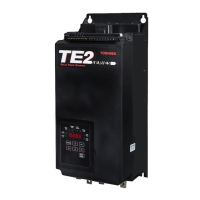TE2
Series Digital Solid State Soft Starter User Manual 18 | Page
4.2.2 Three-Wire Control Connection
For standard 3-wire control, connect dry (voltage free) contacts for the
Stop / Start buttons as shown on the diagram directly above the terminal
strip. Connect the N.O. contact of the Start button to Terminal 1 (far left
terminal), the common point between the Stop and Start to Terminal 2
(2
nd
from left) and the N.C. from the Stop button to Terminal 3 (3
rd
from
left).
4.2.2.a Seal In Contact
The TE2 Series uses an internally pre-wired “seal-in” contact
around the Start button (Terminals 1 and 2). No external relay or
auxiliary output connection is necessary.
4.2.3 Two Wire Control: Relay / PLC Connection
An alternate connection for automated or unattended operation replaces
the start/stop push buttons by connecting a dry (voltage free)
maintained contact closure between terminals 1 and 3 as shown in
Figure 4.2.3. When this contact is closed, the TE2 Series starter will
start and run. When it is opened, it is the same as a Stop command.
4.2.3.a Automatic Functions and 2-Wire Control
When using the Auto Reset functions (F052 - F053), special
consideration must be given to using 2-wire control. Refer to section
5.6.8 for details on using Auto-Reset functions.
Note:
When a maintained contact is used for start/stop, it is advisable to
set the overload relay to the manual reset position. This will prevent
the motor from restarting if the thermal overload trips and then cools
down.
CAUTION!
Control Terminals 1-10 of TB1 are configured using solid state
devices powered internally with a 24VDC power supply. To prevent
damage to the TE2 Series control board, use dry (unpowered)
contact closures only when connecting to these terminals.
If existing 120VAC or other powered control circuit must be
interfaced, use isolating relays.
4.2.4 Interlock Connection
TB1 provides a connection point for an external dry (voltage free) N.C.
(Normally Closed) interlock device between terminals 4 and 5.
Examples where this interlock connection would be used include low oil,
high temperature, or excess vibration dropout from user supplied
devices. A factory-installed jumper is provided which allows the TE2
Series unit to operate if external interlocks are not used. If this jumper is
removed and an interlock is not used, the TE2 Series unit will not
function.

